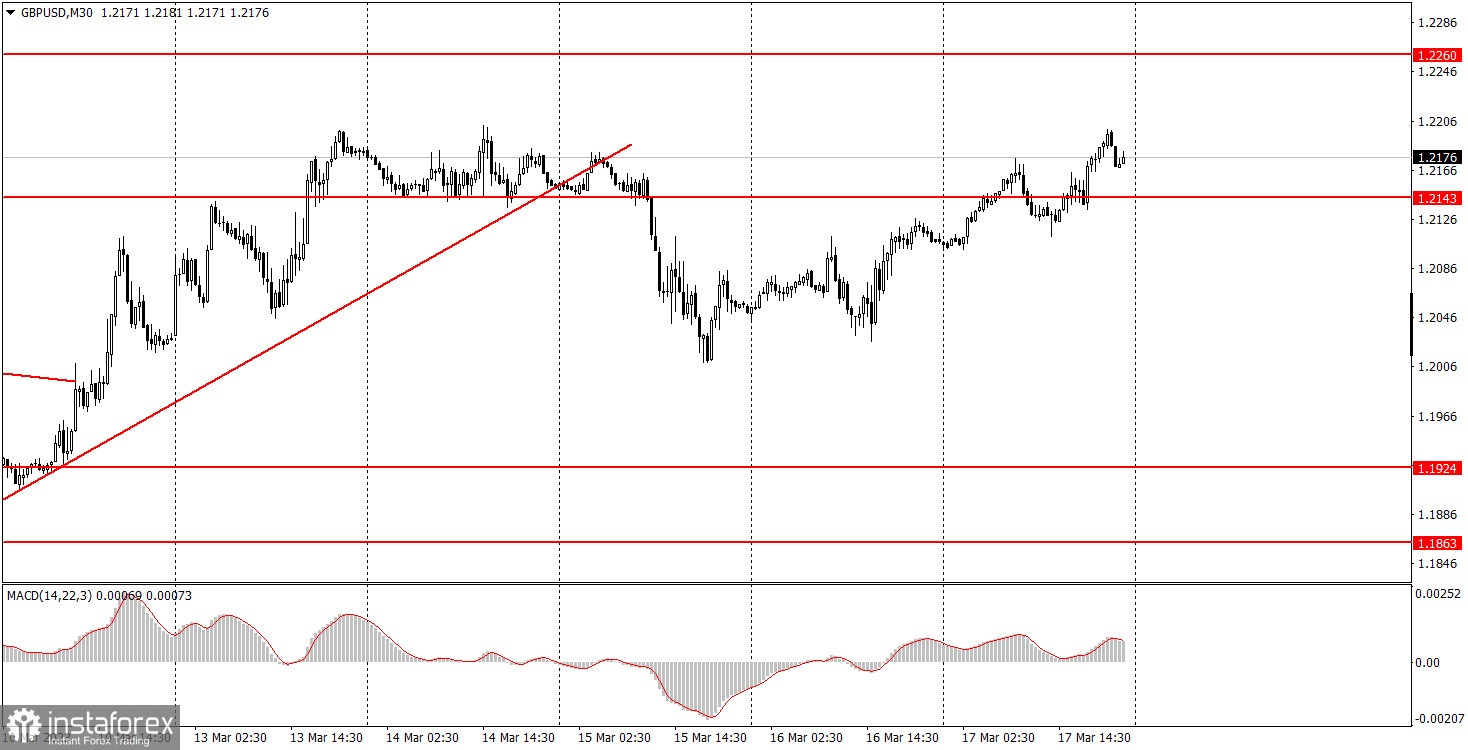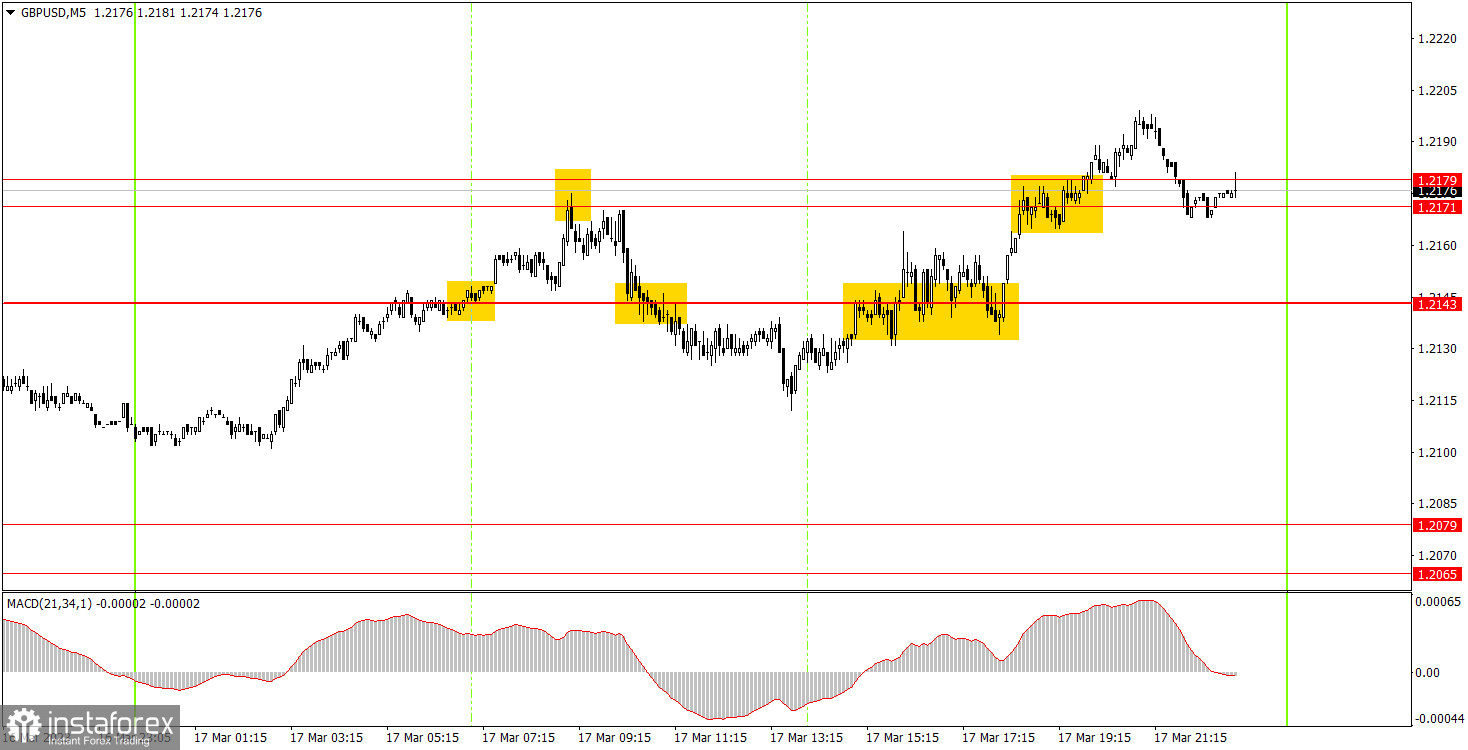Analyzing Friday's trades:
GBP/USD on 30M chart

GBP/USD also continued its bullish correction on Friday, though it is difficult to call it a correction in its purest form. The pound has settled below the trend line, but it did not fall further. Therefore, the trend has formally changed to a downward one, but then again the pair has been growing for two days already. In general, the technical picture on the 30-minute chart is as confusing as possible. However, what is surprising is that if you look at the 24-hour chart, the pair has been in the horizontal channel for several months, but on the 4-hour chart, we have been observing "swings". Friday's macroeconomic background was not particularly important. In America, there were reports on industrial production and consumer sentiment, which turned out to be worse than expected. Perhaps that is why we saw the dollar fall in the afternoon. In the UK, there was nothing interesting at all. For almost the entire week, the pound simply followed the euro.
GBP/USD on 5M chart

There were quite a lot of trading signals on the 5-minute chart, but the pair also changed direction at least twice during the day. Most of the signals were formed between the levels of 1.2143 and 1.2179, and there were less than 40 points between them. The volatility of the European and US trading sessions amounted to 85 points, which is not much. Therefore, beginners could only be busy with pipsing on Friday. The first buy signal brought them no more than 10 points. The second sell signal is also 10 points (closing the position after the price settles above 1.2143). A buy signal around 1.2143 also brought no more than 10 pips. And that's even better. It was not the most successful day, but at least it still ended in profit.
Trading tips on Monday:
On the 30-minute chart, GBP/USD continues to trade on the classic "swing". It may not be obvious on this timeframe, but when moving to higher charts, it becomes clear as day. Therefore, you should keep in mind that in the near future, the movements might turn out to be completely random. And also volatile this week, since two central banks will hold meetings. On the 5-minute chart, it is recommended to trade at the levels 1.1863-1.1877, 1.1924, 1.1992-1.2008, 1.2065-1.2079, 1.2143, 1.2171-1.2179, 1.2245-1.2260, 1.2337-1.2343, 1.2387. As soon as the price passes 20 pips in the right direction, you should set a Stop Loss to breakeven. There are no major events scheduled in either the US or the UK. Traders will have nothing to react to, but a little later this week (on Wednesday and Thursday), the Bank of England and the Federal Reserve will hold their own respective meetings. Therefore, strong movements may begin earlier than these days.
Basic rules of the trading system:
1) The strength of the signal is determined by the time it took the signal to form (a rebound or a breakout of the level). The quicker it is formed, the stronger the signal is.
2) If two or more positions were opened near a certain level based on a false signal (which did not trigger a Take Profit or test the nearest target level), then all subsequent signals at this level should be ignored.
3) When trading flat, a pair can form multiple false signals or not form them at all. In any case, it is better to stop trading at the first sign of a flat movement.
4) Trades should be opened in the period between the start of the European session and the middle of the US trading hours when all positions must be closed manually.
5) You can trade using signals from the MACD indicator on the 30-minute time frame only amid strong volatility and a clear trend that should be confirmed by a trendline or a trend channel.
6) If two levels are located too close to each other (from 5 to 15 pips), they should be considered support and resistance levels.
On the chart:
Support and Resistance levels are the levels that serve as targets when buying or selling the pair. You can place Take Profit near these levels.
Red lines are channels or trend lines that display the current trend and show in which direction it is better to trade now.
The MACD indicator (14, 22, and 3) consists of a histogram and a signal line. When they cross, this is a signal to enter the market. It is recommended to use this indicator in combination with trend patterns (channels and trendlines).
Important announcements and economic reports that can be found on the economic calendar can seriously influence the trajectory of a currency pair. Therefore, at the time of their release, we recommend trading as carefully as possible or exiting the market in order to avoid sharp price fluctuations.
Beginners on Forex should remember that not every single trade has to be profitable. The development of a clear strategy and money management is the key to success in trading over a long period of time.
 English
English 
 Русский
Русский Bahasa Indonesia
Bahasa Indonesia Bahasa Malay
Bahasa Malay ไทย
ไทย Español
Español Deutsch
Deutsch Български
Български Français
Français Tiếng Việt
Tiếng Việt 中文
中文 বাংলা
বাংলা हिन्दी
हिन्दी Čeština
Čeština Українська
Українська Română
Română

